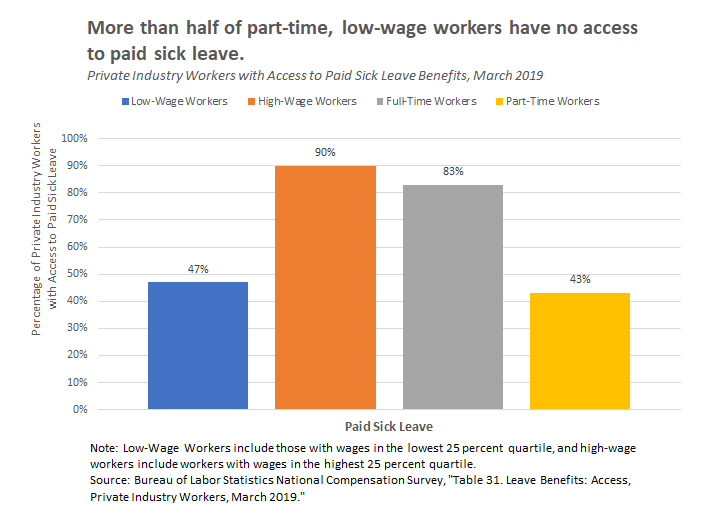Low-Wage Workers Least Likely to Have Paid Sick Days
By Adewale Maye
With flu season approaching, those of us in the workers’ rights space naturally think about how workers without paid sick time will fare. So, we turned to the U.S. Bureau of Labor Statistics’ most recent National Compensation Survey (NCS), which provides current information on workplace benefits such as paid sick days. According to the 2019 NCS, about 73 percent of private industry workers had access to paid sick leave—an improvement from 68 percent in 2017 and 71 percent in 2018. However, over 32 million workers still don’t have paid sick days and, in many cases, have to choose between a day’s pay and looking after their health or the health of a loved one.
While campaigns for paid sick days laws continue to grow, with more states and cities adopting these critical policies, many workers continue to struggle—specifically workers in low-wage jobs and sectors, many of them filled by workers of color.
Wages are often a proxy for the gap in benefits among workers. Among private industry workers, only 47 percent of the lowest wage workers have sick leave compared to 90 percent of the highest wage workers. That means more than half of low-wage workers such as food service workers and child care providers may have to work through mild to severe health conditions or send their sick children to school to escape the risk of losing a full day’s income or, worse yet, risk losing their job by simply taking a sick day. This is the reality for many low-wage workers.
Part-time workers also often have fewer employer-provided benefits and face numerous barriers to economic security such as poverty-level wages and unpredictable work schedules. Only 43 percent of part-time private industry employees have paid sick leave compared to 83 percent of full-time private industry workers. Despite slight improvements from previous years, systemic gaps in benefits for low-wage, part-time employees persist. Low-wage, part-time workers at small firms (1 to 99 workers) are often the most vulnerable in the workforce when it comes to worker benefits.

The NCS also reveals shocking disparities in access to paid sick leave for those employed by large employers compared to small employers. Eighty-four percent of private industry workers at larger firms (100+ employees) have sick leave compared to only 65 percent who work at smaller firms.
Union jobs continue to provide workers with much-needed benefits and supports such as paid sick days. Eighty-six percent of union workers have sick leave, compared to 72 percent of nonunion workers.
The good news is that more and more workers, advocates, and policymakers in states and cities are harnessing public will in support of paid sick days to pass laws requiring such leave, with 33 jurisdictions having done so. Most recently, Nevada has joined these states, cities and jurisdictions in requiring all private sector employers to provide their workers with paid sick days. While we are making gains, the NCS data confirms we have a lot more work to do to help those workers who most need paid sick days.
While state and local laws are important, the best solution for all workers are federal policies like the Healthy Families Act, which would establish a national paid sick days standard and make a huge difference in the lives of low-income workers everywhere—during flu season and throughout the year
